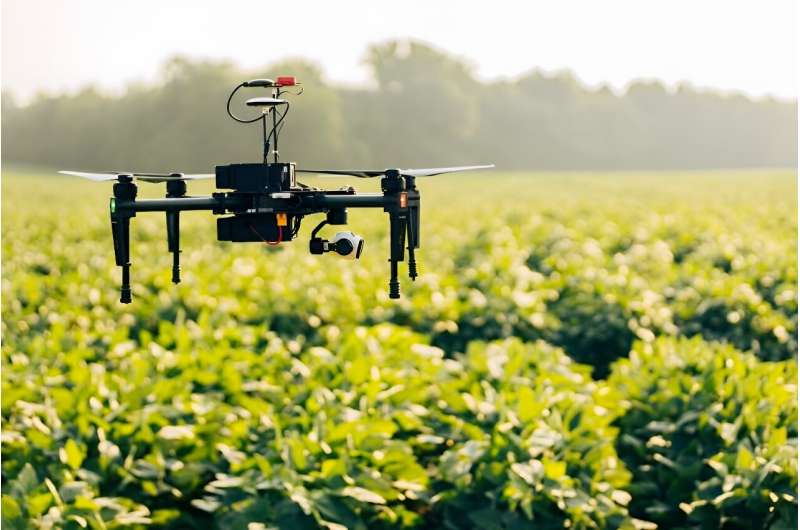This article has been reviewed according to Science X's editorial process and policies. Editors have highlighted the following attributes while ensuring the content's credibility:
fact-checked
trusted source
proofread
Harnessing sensors, smart devices, and AI could transform agriculture

Biosensing engineer Azahar Ali, assistant professor of animal sciences and biological systems engineering at Virginia Tech, is bracing for the arrival of a fourth agricultural revolution.
It's an era predicted to tap into the transformative potential of the connective technologies that have arisen in the Fourth Industrial Revolution. To Ali, three technologies stand out for their potential to advance climate-smart, precision agriculture: wearable agriculture sensors, Internet of Things-enabled—or "smart"—devices, and artificial intelligence (AI).
In a review article published by Advanced Intelligent Systems, Ali and colleagues Matin Ataei Kachouei of the School of Animal Sciences and Ajeet Kaushik of Florida Polytechnic University wrote that merging these cutting-edge technologies could create a paradigm shift in how the agricultural sector monitors food safety and quality and plant health and productivity worldwide.
For Ali, prioritizing rapid, accurate, early monitoring will be critical to sustainably and safely feeding the fast-growing global population, which is expected to be nearly 10 billion by 2050 and will require 50 percent more food to maintain the world's food supply chain, according to the article.
According to the 2023 Global Agricultural Productivity, or GAP, Report, released through the College of Agriculture and Life Sciences, the growth of global agricultural productivity has significantly contracted, and current efforts to sustainably expand production are inadequate.
Ali said researchers must collaborate to tap into the full potential of new technologies that could help producers keep up with future demand. Agronomists must work with engineering, human and veterinary medicine, and materials science experts.
"There's a huge gap in this kind of collaboration," Ali said. "I develop sensors, but I need to collaborate with experts in machine learning. We need to engage in more collaboration to solve the food crisis."
In their article, Ali, Kachouei, and Kaushik laid out the recent progress researchers have made in applying sensors, smart devices, and AI in monitoring food and plants. They also describe the potential and challenges of combining the technologies.
Food sensor technology has seen remarkable development, they wrote, with a focus on measuring toxins, humidity, pH, freshness, temperature, contaminants, and pathogens. Keeping tabs on these factors is key to food safety, food quality, and high packaging standards.
The researchers described how these sensing capabilities could be enhanced when paired with other technologies: With the pairing of sensors and smart devices, food, livestock, and plant sensing systems could precisely collect data in real-time, on-site, and at a large scale. Next-generation networks could then quickly transmit the high-volume data generated by those systems.
AI could streamline data analysis through automatic data processing, the researchers wrote. AI could take on the volumes of data generated by smart sensors, Ali said. Smart devices and AI also offer the potential for predictive analysis, enabling producers to anticipate challenges such as disease outbreaks and weather patterns proactively.
Throughout the article, Ali and his colleagues highlighted examples of how researchers are currently exploring the integration of multiple technologies, including the development of electrochemical sensors used to detect disease biomarkers in cow milk, orange juice, and apple juice and the use of microneedle-based integrated plant sensors alongside smartphone-based 3D-printed devices to detect viruses in tomatoes.
Ali and his colleagues see promise in these solutions, but they also noted existing challenges for tapping into the technologies of the fourth agricultural revolution: There are security concerns in data collection using smart sensors; the costs of sensors, network infrastructure, and data management could be prohibitive; and there could be internet connectivity issues when using smart devices in the rural or remote areas where many farms are located.
To address those challenges, Ali pointed back to collaboration among scientists, policymakers, and farmers. "To solve our common problems, we need to work together," he said.
More information: Matin Ataei Kachouei et al, Internet of Things‐Enabled Food and Plant Sensors to Empower Sustainability, Advanced Intelligent Systems (2023). DOI: 10.1002/aisy.202300321
Provided by Virginia Tech





















